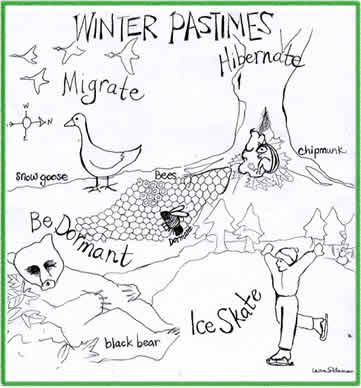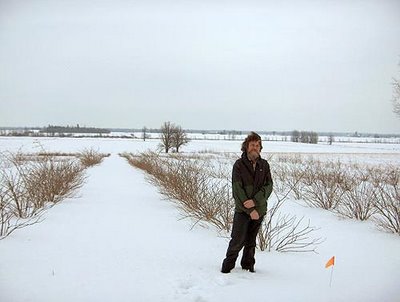Around this time of year, many friends ask me – Do you and the bees hibernate through the winter? Usually, I give a chuckle and respond, ” No, we do the same thing, we are active” . While we work to sustain the momentum of Honey Gardens through the winter and seasons, the bees work to sustain the warmth and life of the hive through the winter and into the new season. In the time when the nectar flows dwindle, the male drones are escorted from the hive, to die on the ground outside the hive entrance. There is no use for the drones in the winter and this action allows for the hive to have larger stores (honey, pollen) and thus greater chances of surviving the winter. As the cold winds lower the temperature of the hives in winter, the bees then huddle around the queen in a football size cluster, keeping her a comfortable 95 degrees F. The worker bees move their bodies to create warmth. Bees farther away will cycle to the center where it is the warmest, and bees here will move towards the outside.

The bees are “dormant” in the winter, they slow down, but are still active. Bears go into a state of deep torpor, similar to hibernation but are not fully asleep. In this more restful stage, an average worker bee will live six months in the winter, compared to six weeks in the summer, where her life is limited to how long her wings will last with all the greater scope and intensity of work.
When there is a break in the winter weather, around the third week in March, we will go out and check the bees. Honey will be transferred from hives that have died to those that have survived and are light on these stores. This a very symbolic move, to support and give life from those that have passed on. The season of working with the bees begins when there is snow on the ground and will end months later with the first snows of the winter season.
Last week/ le dernier semaine our daughter/notre fille Meriwether and I journeyed north/nord into the snowy white fields/terre de neige blanc of Quebec to bring back the first load of elderberries/les sureau. I have watched these purple jewels of certified organic/biologique agriculture grow, and now they will be used to make plant medicine and elderberry honey wine.

Robert with his three year old elderberry plants
It was moving to see how much we share. More significant than Robert’s farm/ferme being within three miles of the US border/ la frontiere, we saw the thread of unity/unite through our visit. As in Vermont, the land is in transition, from dairy to vegetables, apples, pears, cut flowers, maple syrup, bees, elderberry. Political boundaries become transparent when the conversation turns to one’s parents, how the lack of snow this winter means less insulation for the plants, and who is the real threat in the world. Through paths worn by dairy cows, we gathered buckets of elderberries from freezers throughout the barn where his father had worked for many years.
As in Ontario, the color company had inspired farmers to plant acreage of elderberries for the beautiful purple blue color that comes from these berries, and then only will pay less than the cost of production. Because of the determination and hard work of these farmers, with encouragement from Agriculture Canada, new markets are being found for this traditional berry that has the anti-viral agents to help with colds and flu, building up immunity in a natural way that chemical medicines could never offer.
Honey Gardens is honored to be part of this commerce and strengthen alliances with our neighboring friends. Because of your support, farmers have been brought together who did not have a market with those that did not have enough crop to supply the market that increasingly appreciates the healing power of an old traditional berry.
thank you all very much for everything/merci beaucoup pour le toutes les choses.